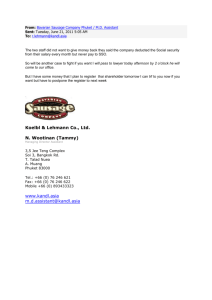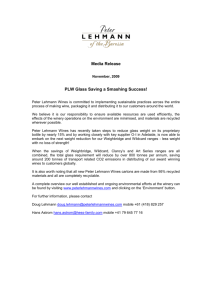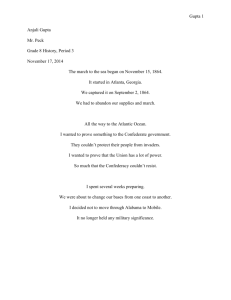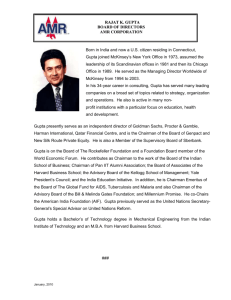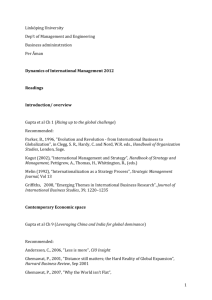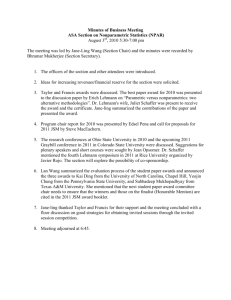MBA6140 Quiz 7
advertisement
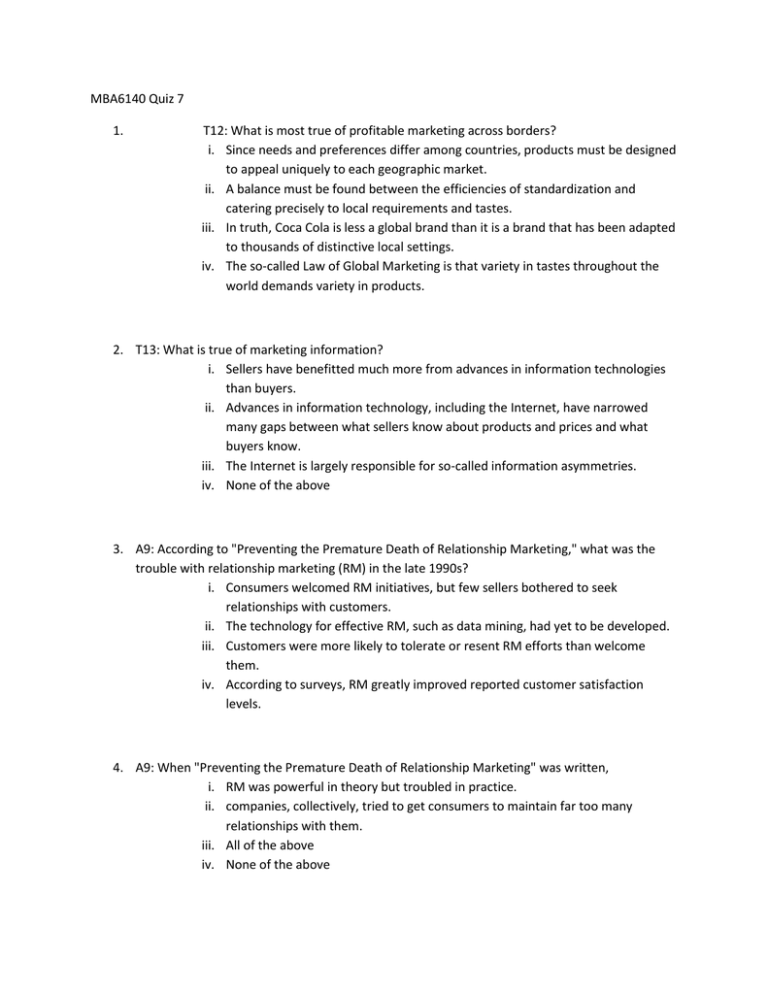
MBA6140 Quiz 7 1. T12: What is most true of profitable marketing across borders? i. Since needs and preferences differ among countries, products must be designed to appeal uniquely to each geographic market. ii. A balance must be found between the efficiencies of standardization and catering precisely to local requirements and tastes. iii. In truth, Coca Cola is less a global brand than it is a brand that has been adapted to thousands of distinctive local settings. iv. The so-called Law of Global Marketing is that variety in tastes throughout the world demands variety in products. 2. T13: What is true of marketing information? i. Sellers have benefitted much more from advances in information technologies than buyers. ii. Advances in information technology, including the Internet, have narrowed many gaps between what sellers know about products and prices and what buyers know. iii. The Internet is largely responsible for so-called information asymmetries. iv. None of the above 3. A9: According to "Preventing the Premature Death of Relationship Marketing," what was the trouble with relationship marketing (RM) in the late 1990s? i. Consumers welcomed RM initiatives, but few sellers bothered to seek relationships with customers. ii. The technology for effective RM, such as data mining, had yet to be developed. iii. Customers were more likely to tolerate or resent RM efforts than welcome them. iv. According to surveys, RM greatly improved reported customer satisfaction levels. 4. A9: When "Preventing the Premature Death of Relationship Marketing" was written, i. RM was powerful in theory but troubled in practice. ii. companies, collectively, tried to get consumers to maintain far too many relationships with them. iii. All of the above iv. None of the above 5. A9: When "Preventing the Premature Death of Relationship Marketing" was written, what did sellers often fail to do? i. Offer incentives that truly promoted customer loyalty ii. Give customers as much friendship, loyalty, and respect as they tried to get via RM iii. All of the above iv. None of the above 6. A9: Which practice advocated in "Diamonds in the Data Mine" (A5) would the authors of "Preventing the Premature Death of Relationship Marketing" question? i. Using RM to develop customer loyalty ii. The ethics of providing incentives to customers who may be trying to break bad habits iii. Relying on data mining to simulate personal relationships iv. Treating "best customers" much better than ordinary customers v. None of the above; nothing in "Preventing the Premature Death of Relationship Marketing" suggests its authors would question anything in "Diamonds in the Data Mine" 7. A9: Sir Alan Sugar once said, "Pan Am takes good care of you. Marks & Spencer loves you. Securious cares. At Amstrad, we want your money." What does the article "Preventing the Premature Death of Relationship Marketing" suggest about this sort of frankness? i. RM cannot work unless marketers put customer interests above profits. ii. Sellers should tell customers why an offer is a good one; trying to hide motives for seeking relationships is ill-advised. iii. RM initiatives should sell friendship, not products. iv. Being honest with customers is too much to expect. 8. A9. What do the authors of "Preventing the Premature Death of Relationship Marketing" suggest? i. Data mining is the key to understanding customers. ii. Understanding customers requires qualitative research. iii. All of the above iv. None of the above 9. A9: How do the authors of "Preventing the Premature Death of Relationship Marketing" view marketers? i. company representatives ii. customer advocates iii. All of the above iv. None of the above 10. C5: What happened to Jane? i. She was given an accurate price for the minivan she wanted, but was deliberately misled about the trade-in value of her car ii. She was misled into believing that the warranty on the used minivan she bought was longer than it turned out to be when she experienced transmission problems. iii. She was given a new minivan to drive while her minivan was being repaired, which was a sales trick intended to get her to trade her old minivan in on a new one. iv. None of the above 11. N10: In the article "Ethical Implications of Target Market Selection," the authors develop which theme? i. People should take responsibility for their actions and not blame bad choices on marketers. ii. Whether it is ethical to promote a product depends purely on the product and not on the targeted segment. iii. Whether target marketing is ethical often depends on both the type of product and the characteristics of the people being targeted iv. There's never anything unethical about marketing legal products to adults. 12. N10: In the article "Ethical Implications of Target Market Selection," the authors suggest that marketers should proceed with caution when targeting which group or groups? i. children ii. people in underdeveloped countries iii. poorly educated adults iv. All of the above 13. N10: With regard to hair restoration products, how would the authors of the article "Ethical Implications of Target Market Selection" classify a balding adult of normal intelligence who desperately wants to stop hair loss? i. sophisticated ii. at risk iii. vulnerable iv. gullible 14. N10: According to the article "Ethical Implications of Target Market Selection," what may prevent a person from using available information to make sound decisions? i. bounded rationality ii. cognitive dissonance iii. All of the above iv. None of the above 15. N10: In the article "Ethical Implications of Target Market Selection," costs borne directly by nonparticipants in an exchange are referred to as i. peripherals ii. internalities iii. externalities iv. demerits 16. N11: Kotler suggests that the essence if the marketing concept is, "Give the customer what he wants." What does this axiom imply? i. Identify customer needs, wants, and preferences using marketing research; then apply what is learned. ii. The customer knows best. iii. Seller beware. iv. Don't question what the customer wants. 17. N11: According to Kotler, what must usually be done to get companies to change practices that are profitable, but are not in the best interest of the public at large. i. Their offerings must be boycotted. ii. Legislation must be imposed that forces them to change. iii. Some form of public pressure must be exerted on them. iv. They must be left alone because, as long as markets are free, socially irresponsible companies will be punished by the market. 18. N11: The notion that the law represents the minimal moral standards of a society is reflected in the writings of i. Karl Marx and Mao Tse Tung ii. Plato, Jeremy Bentham, and John Stuart Mill iii. Immanuel Kant; specifically, his categorical imperative iv. Thomas Hobbes and John Locke 19. N11: What does Kotler say about himself? i. He has refused to help businesses market harmful products. ii. Much like Ralph Nader, he has become uncompromising consumer advocate. iii. He has concluded that, as long as people want to buy certain harmful products, the marketer's calling is to make such products available. iv. None of the above 20. According to Gupta & Lehmann, marketing managers should design customer-based strategies that focus on i. customer acquisition ii. profit margin per customer iii. customer retention iv. All of the above 21. From Gupta & Lehmann's perspective, customer value refers to what? i. The value the firm provides customers. ii. The value of customers to the firm. iii. All of the above iv. None of the above 22. According to Gupta & Lehmann, studies show that the typical merger i. creates significant market and/or operating synergy and, thus, increases shareholder value ii. neither creates nor destroys shareholder value iii. destroys shareholder value iv. results is substantial cost reductions that create shareholder value 23. Regarding AT&T's acquisition of TCI and MediaOne, i. AT&T spent $4,200 per customer ii. AT&T would require nearly a 44% profit margin, even under very optimistic assumptions, to break even iii. All of the above iv. None of the above 24. According to Gupta & Lehmann, one effect of the bursting of the internet bubble is that analysts are gradually beginning to appreciate the value of customer-based measures, especially number of customers, and the limitations of financial measures. i. True ii. False 25. According to Gupta & Lehmann, what is true of marketing programs? i. Cross-selling and up-selling programs aim at increasing margin per customer. ii. Customer service and loyalty programs aim at increasing retention iii. All of the aabove iv. None of the above 26. Gupta and Lehmann claim that, if you can figure out where a firm's relationships with its customers are headed, you have a strong start on understanding a firm's value and long-term stock price. Accordingly, you need to estimate where which of the following are headed over time? i. the customer acquisition rate ii. the customer retention rate iii. the change in margin per customer iv. the acquisition cost v. the retention cost vi. All of the above 27. Gupta & Lehmann suggest that organically growing your business entails i. acquiring new customers, but not by acquiring another firm ii. iii. iv. v. retaining existing customers exacting more revenues and profits from existing customers All of the above acquiring customers by acquiring another firm 28. Gupta & Lehmann suggest that the purpose of a profit tree is i. very similar to the purpose of defensive analysis in a situation assessment ii. to show critical decision points and how a customer generates profits iii. to show how a firm can leverage its customer base iv. All of the above 29. According to Gupta & Lehmann, one feature of profit trees is that they i. isolate decision points so that there are no interactions, for example, between acquisition decisions and overall retention costs or margins ii. allude to interdependencies among decisions, for example, between acquisition decisions and overall retention costs and margins iii. point to how firms can steel customers from competitors iv. None of the above 30. With the intent of conveying that, maintaining its cars is cheaper than maintaining other brands, Honda once used the slogan, We keep it simple. In Gupta & Lehmann's vernacular, the type of value to which Honda alluded is i. economic ii. functional iii. All of the above iv. None of the above 31. A maker of luggage once demonstrated that its suitcases would not open accidentally by showing them being thrown around by an ape. In Gupta & Lehmann's vernacular, the type of value to which this demonstration alluded is i. economic ii. functional iii. All of the above iv. None of the above 32. According to Gupta & Lehmann, what is true of brand equity? i. Brand awareness is a source of brand equity ii. Brand loyalty makes the strongest contribution to brand equity iii. All of the above iv. Brand equity is measured by dividing stock price by the book value of a firm's assets. 33. According to Gupta & Lehmann, what is true of frequent discounting? i. It can lead to erosion of brand equity. ii. It can decrease customer loyalty. iii. It can increase customer price sensitivity iv. All of the above 34. Gupta & Lehmann advise companies to i. build cause-effect models in which customer value to the firm is the dependent variable and variables such as loyalty and satisfaction are causal antecedents ii. identify which variables have the greatest impact on customer value to the firm by collecting and analyzing pertinent data iii. All of the above iv. rely predominantly on knowledge gained from experience to identify the variables that have the greatest impact on customer value to the firm 35. What do Gupta & Lehmann have to say about firms that are organized along product lines (e.g., Toyota's Scion, Toyota, and Lexus brands)? i. Such structures tend to reward brand managers for maximizing brand profitability, which may be detrimental to firm profitability. ii. Were the Toyota company truly a customer centered organization, then some customers looking for a top-of-the-line Toyota would be steered away from buying a Toyota and onto buying a Lexus. iii. Designing organizational structures in which information is exchanged freely among product-based divisions and incentives reward doing what's best for the firm, rather than the division, is difficult. iv. All of the above

